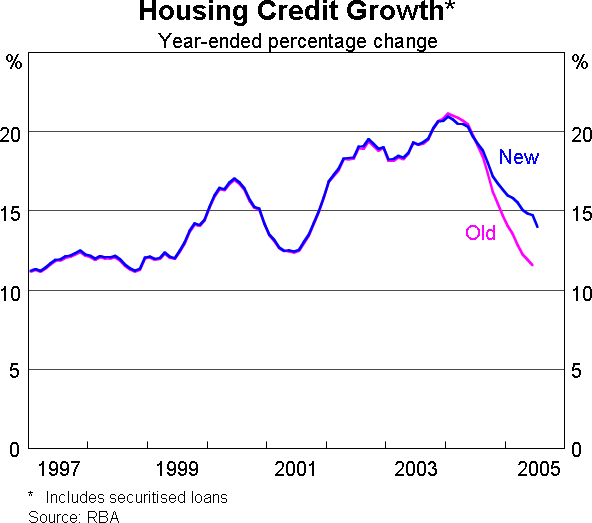Explanatory Note on Revisions to Housing Credit Data 31 August 2005
Over recent years there have been some major innovations in the provision of housing finance. The most important have been the growth in specialist mortgage originators, and the increasing use of securitisation. A problem posed by these changes is that these non-traditional lenders are neither authorised deposit-taking institutions (ADIs) nor reporting registered financial corporations, so their lending is not captured in the standard monthly data collections for ‘all financial intermediaries’ (AFIs).
As a result of these developments, the Bank made a major change to the construction of the housing credit data in May 2004 to bring the stock of securitised loans into the definition of housing credit. These changes involved redefining housing credit to be the sum of all housing debt, whether remaining on the balance sheets of AFIs or securitised in mortgage-backed securities (MBS). At that time the Bank noted that it would continue to monitor developments in the pattern of financing, and would make whatever changes to the data compilation were necessary to keep the data relevant.
The method adopted until now for calculating housing credit has been to add quarterly ABS data on the stock of securitised housing loans to data for the on-balance-sheet lending of AFIs. Because of the quarterly frequency of the ABS data for securitised loans, initial monthly estimates of credit have been based on RBA estimates of monthly securitisations. These have been based on monthly data for MBS issued by ADIs, plus estimates of lending by the non-traditional lenders, based on ABS data for loan approvals for these lenders.
Historically, such monthly estimates of the stock of securitised loans were typically quite close to the subsequent quarterly ABS data. However, over about the past twelve months, the stock of securitised loans published by the ABS has been growing more slowly than suggested by the Bank's initial monthly estimates. This resulted in downward revisions to the credit data when ABS securitisation figures became available.
The Bank has investigated the reasons for these discrepancies, in conjunction with the ABS and market sources. The primary reason appears to be that some securitisers have not included issuance of privately-placed MBS in the data reported to the ABS. The private placement market is a relatively new, though rapidly growing, segment of the MBS market, resulting from a demand by some large investors for custom-tailored securities from mortgage lenders.
An additional recent development in housing lending has been an increased tendency for non-traditional lenders to finance their lending from sources other than loan securitisation. As a result, the stock of securitised loans does not reflect the full amount of loans issued by these lenders.
The revised estimates for housing credit in this month's release incorporate estimates for both of these developments and the effect of the annual re-estimation of seasonal factors. Compared to the numbers published in July 2005, the revised monthly growth rates for housing credit are between 0.1 and 0.4 percentage points higher from May 2004 to the present. Consequently, the year-ended growth rate, at 14.0 per cent in July, is around 3 percentage points higher than suggested under the previous approach. Despite the upward revision to the growth rates, the revised data still suggest that housing credit growth is moderating, albeit more gradually than previously suggested.

While these figures incorporate the Bank's best estimates of the effect of the developments described above, they are subject to further revision, particularly due to lags in the availability of data on loan securitisation and lending by non-AFIs. Given the importance of good data on housing credit, the Bank will be looking in the months ahead to establish regular data collection to fill current gaps, especially in regard to the mortgage originators. These improved data will be incorporated into the credit data as they become available.